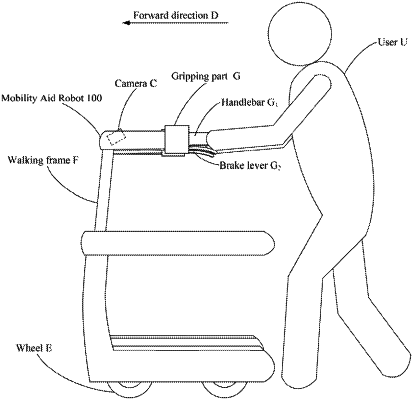| CPC G06V 20/10 (2022.01) [G06F 18/214 (2023.01); G06V 10/235 (2022.01); G06V 40/164 (2022.01); G06V 40/171 (2022.01); G06V 40/25 (2022.01)] | 20 Claims |

|
1. A human abnormal behavior response method for a mobility aid robot, wherein the robot has at least a gripping part disposed toward a body of a human for the human to grip, and a camera disposed toward the body of the human to shoot a face of the human, and the method comprises:
planning a trajectory for the robot to move from a starting point to a destination, and controlling the robot to move according to the trajectory;
detecting, through the camera, the face of the human during the robot aiding the human to move;
comparing an initial size of the face and an immediate size of the face in response to the face of the human having detected during the robot aiding the human to move;
determining the human is in one or more abnormal behaviors in response to the immediate size of the face being smaller than the initial size of the face; and
performing one or more responses corresponding to the one or more abnormal behaviors in response to the human being in the one or more abnormal behaviors, wherein the one or more responses include slowing down the robot;
wherein the one or more abnormal behaviors comprise drowsiness, and the performing the one or more responses corresponding to the one or more abnormal behaviors in response to the human being in the one or more abnormal behaviors comprises:
adjusting the trajectory in response to the human being drowsy;
wherein before performing the one or more responses corresponding to the one or more abnormal behaviors, the method further comprises:
filtering out a false positive detection from the one or more abnormal behaviors based on a confidence score and detecting results of non-visual based abnormal behavior detectors, wherein the detecting results comprises: a result of heart rate sensing, and results of grip force and torque sensing, skin conductivity, and a motor current used to drive the robot, and the confidence score is computed using a weighted sum of detection factors corresponding to the non-visual based abnormal behavior detectors.
|